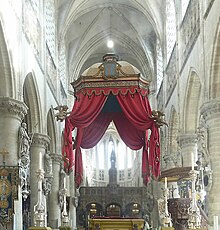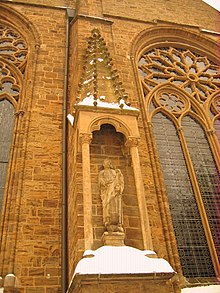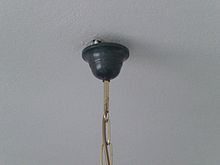canopy





A canopy , also called heaven , is either a supporting canopy - an umbrella-like sun and ornamental roof that is carried over the monstrance in church processions - or a permanently mounted pomp and ornamental roof for thrones , bishoprics , altars , beds and other things. Canopies can also be suspended from a room ceiling. In architecture, the term refers to stone ornamental roofs, for example over monuments or pulpits, or ornate gables. In addition, there are transferred meanings of words.
In the church sector, various forms of canopy are also known as conopeum .
Word origin
Canopies were originally made from brocade fabric. The word baldachin is derived from Italian baldacchino , Middle High German baldekin and originally referred to a gold brocade fabric made in baldach ( Middle Latin for Baghdad ).
The word baldachin has been used in German as a name for the canopy of the throne since 1667.
Portable canopies
Origin in the Orient
Oriental rulers appeared in earlier times as a sign of dignity under a canopy worn by servants. These canopies served on the one hand as protection from the sun - they were therefore the forerunners of modern sunshades - but on the other hand also to emphasize their dignity. Canopies came to the West as gifts in the early Middle Ages. They were later spread across Europe through the Crusades and trade between oriental states and Venice .
Canopies in church processions
In the Roman Catholic Church , a canopy, also known as "heaven" or "carrying heaven", is held in sacraments so that it is above the holy of holies . This has been customary since the 14th century. The bearers of the bars of heaven are also called "heaven bearers". In the Middle Ages, the bishop was also led under a canopy at a solemn reception, and on certain days the Pope walked to the altar under a canopy.
A collapsible umbrella that is held over the priest in the event of a mistake is called an "umbella" (umbaculum) .
Fixed ornamental roofs made of fabric
Bed canopy
In the secular and private sphere, the four-poster bed that emerged in the Middle Ages , a four-post bed with canopy and, if necessary, curtains, is still important today . Often secret compartments were placed on bed canopies, in which the savings were placed on the " high edge ".
Chuppah
The Jewish wedding traditionally takes place under a fabric canopy, the so-called chuppah . The wedding canopy symbolizes the new husband's house on the one hand, and the wife's place of work on the other. The fabric canopy that is common today has been in use since around the 16th century. The term chuppah has become synonymous with the Jewish wedding.
Architecture and sculpture
Canopies also appear as elements of architecture, for example as a roof over a monument . In this case, they are made of stone.
An altar canopy resting on columns is called a canopy or, more precisely, especially in early Christian churches, as a ciborium . In addition to stone, other solid materials such as wood or metal were used for such structures. The ciborium in St. Peter's Basilica , created by the sculptor Gian Lorenzo Bernini , consists almost entirely of bronze, only the pedestals of the four columns are made of marble. Bernini's work is considered an innovative combination of ciborium and canopy, as he decorated the canopy of the altar on pillars (the ciborium) with the hanging cloth typical of a canopy, which, however, he reproduced with the bronze tassels .
Transferred word meanings
heraldry
In heraldry , the so-called purple canopy is part of a full coat of arms .
Aircraft construction
In aircraft in high-deck or double-decker -construction which is above the hull center piece of the overhead, the upper supporting surface and the structural member, which is this with the fuselage connects referred to as a canopy. The latter is usually an open framework made of stems and struts that connects the top of the fuselage with the upper center section of the wing. The canopy is often used to hold a fuel tank.
Electrical installation
In the field of electrical installation , junction boxes on the ceiling, typically for lights , are also known as lamp canopies. It is usually a plastic hollow part that is used to conceal electrical connections. The canopy conceals the ceiling outlet for the supply cable. In addition to providing safety-relevant protection against touch voltage, it mainly serves aesthetics by hiding undecorative cable connections and terminals .
Similar roofing
Also, cradles , bassinets , cots, strollers and porch swings often have a sky-like roof made of cloth. However, this is usually not referred to as a canopy, unless it is a particularly elaborate, lavishly ornamented, tent-like construction.
In the outdoor area ( city , garden and park furniture), temporary party tents without side walls (so-called garden or party pavilions ) have the character of canopies.
In architecture, canopies are formally comparable with flight roofs . These are seemingly floating canopies, often on supports. However, larger, functional structures are referred to as a flight roof , while the term canopy is used for smaller, richly decorated and symbolic splendid sky.
literature
- Marga Weber: Baldachines and statue shrines (= Archaeologica. Vol. 87). Giorgio Bretschneider, Rome 1990, ISBN 88-7689-036-X (At the same time: Frankfurt am Main, University, dissertation, 1982).
Web links
Individual evidence
- ↑ See Duden online: Baldachin (meaning 2) and support sky
- ↑ a b Cf. Duden online: Baldachin
- ↑ a b Joseph Braun : The liturgical paraments in the present and past. A manual of paramentics. 2nd, improved edition. Herder, Freiburg (Breisgau) 1924 (reprographic reprint). Verlag Nova und Vetera, Bonn 2005, ISBN 3-936741-07-7 , p. 240.
- ↑ Maurice Lamm: The wedding canopy (chuppah) chabad.org
- ^ Wilfried Copenhagen : Transpress Lexicon aviation . 4th revised edition. Transpress , Berlin 1979, p. 67 (keyword: canopy).


